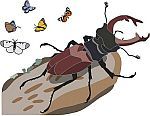Background and Main Issues - LIFE for insects
Background and Main Issues
Background, main issues
The project deals with several threats:
-
Shrub encroachment of sites caused by absence of traditional farming in non-forest habitats
In the second half of the 20th century the landscape of the Western Carpathians changed radically as a result of intensive, large-scale socialistic agriculture, fundamentally affected by collectivisation. The traditional way of farming has only been maintained on small inaccessible sites which were not included into co-operative ownership and which were initially managed by their owners who gradually lost the motivation to mow or pasture them. Subsequently, these islands of original richness saved from intensive agricultural technology have gradually become encroached by self-seeding shrubs and trees.
-
Increasing fragmentation, isolation, and homogenisation of non-forest habitats
Today the landscape is increasingly being fragmented and non-forest habitats are becoming isolated. Invertebrates in particular react very rapidly to these changes because of their short generation cycle. Most insect populations operate in so-called metapopulation systems demanding a sufficient number of other areas and their interconnection. For this reason it is necessary to support and create ‘stepping stones’, i.e. suitable habitats in a dense network so as to balance temporarily unsuitable conditions at some sites with optimal conditions.
-
Abandonment of traditional forest management and conversion of broad-leaved and mixed forests to even-aged spruce monocultures
Wood pasture used to be a key element in agricultural economy from the arrival of the first farmers to the beginning of the Modern Age. Feeding cattle, particularly pigs, was unimaginable without forest fruits such as acorns, hazelnuts, beechnuts, and fleshy fruits. Vegetative sprouting of trees was compatible with grazing, but generative sprouting was less so, as this limited our ancestors in obtaining fuel and forced them to utilise most forests as coppice. Since the 18th century the need increased for construction timber and sizable wood for timbering mines; in addition, better access to tools made the production of charcoal from larger logs easier. Longer rotation periods of the understorey started to change the low and middle forests first into pole- stage stands with scattered reserved trees, later into closed-canopy high forests as we know them today, and wood pasture was forbidden. Therefore, active cultivation of open-canopy middle forests does not exist anymore either in the Czech Republic or Slovakia today, except for small-scale experiments.
